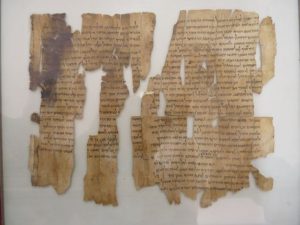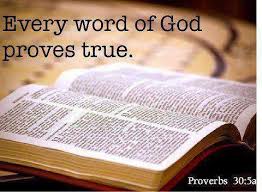When you hear about variants in the Bible does it make you doubt the reliability of Scripture? It shouldn’t if we understand how variants are counted and what scholars have found through the study of ancient Biblical manuscripts. Simply put, the more manuscripts you have the better chance you have in ascertaining the original, and that’s what we’ve been able to do with the Bible!
Last week we looked at the science of textual criticism and how the Bible is in first place, by far, over any other ancient document in the number of ancient manuscripts available to research (over 25,000 compared to Homer’s Iliad in second place with a a little over 1700). Scholars spend their lives studying these early manuscripts and have confirmed that the Bible is 100% reliable in its vox (meaning) and 99.5% in its verba (words) from the original autographs. These manuscripts can be found in museums, libraries and churches around the world for anyone to explore.
Consider this story as an example of what textual critics do:
Ron and Martha had won numerous contests over the years with their special chili recipe. When they retired Martha wanted to pass the recipe on to her family and friends so she hand copied the recipe and sent it out to five people. Ten years later Ron and Martha suffered a devastating house fire, everything was lost. Martha contacted the five people that she had sent the recipe to, but none of them could find their copy. However, each one of them had sent out five copies to friends and family as well. In trying to reconstruct the original they gathered all of the copies (25) that had been sent out. Three of the copies were faded and some words could not be seen. Two of the copies had been slightly altered to try to make the recipe even better. A few of the copies had some spelling errors and a few others had some word order differences. After laying out all 25 copies do you think that they could reconstruct the original recipe?
Of course they could! This is similar to what we have with the New Testament manuscripts, but we don’t just have 25 copies to compare with, we have over 25,000! This is the science of “Textual Criticism” and this is what Biblical scholars spend their lives doing.
“The number of manuscripts of the New Testament, of early translations from it, and of quotations from it in the oldest writers of the Church, is so large that it is practically certain that the true reading of every doubtful passage is preserved in some one or the other of these ancient authorities. This can be said of no other book in the world.”
– Sir Frederick Kenyon, Archeologist, “Our Bible and the Ancient Manuscripts”
And we have the word of the prophets made more certain, and you will do well to pay attention to it, as to a light shining in a dark place, until the day dawns and the morning star rises in your hearts. Above all you must understand that no prophecy of Scripture came about by the prophet’s own interpretation. For prophecy never had its origin in the will of man, but men spoke from God as they were carried along by the Holy Spirit.
2 Peter 1:19-21
Skeptics will claim that there are so many errors or variants counted between the manuscripts that they are not reliable, but textual criticism will show that the opposite is true:
- Because we have tens of thousands of early manuscripts to compare against each other, the variants are easily rectified.
- Variants in the texts mainly stem from differences in spelling, word order or the relationship between noun and definite articles—slight variants that are easily recognizable.
- After factoring out the minor spelling errors and light variations in word order, there is more than 99.5% agreement between all of the known manuscripts of the New Testament and about 98% for the Old Testament.
- Of the remaining variants (0.5-2%) none affect any crucial doctrine or teaching of the Christian faith.
Here’s another example of how we can weed through the variants:
What would you do if you received this text message from someone you know?
“Y#U HAVE ENHERNITED TEN MILL##N DOLLROS”
Then realizing they sent you a text with a lot of mistakes, they tried again:
“YOU HAV HERTED 10 MILL__ OLRAS”
Then again…
PLEASE COME TO PK Up YOUR IN##ITANCE OF 10 MILLION $”
Would you go collect the money? If you compared your messages with the same messages received by others who had already received this same inheritance would you ignore it because your texts seem to have mistakes in them? No, you would go and collect the money because you would have no doubt about the meaning!
- Even with mistakes 100% of the message comes through
- The more errors to compare in a multitude of manuscripts the more sure you are of the message—AND WE HAVE OVER 25,000 AND GROWING!
- The Bible has: More manuscripts, earlier manuscripts, and more accurately copied manuscripts than any other book from the ancient world!
- If you can’t trust the Bible then you can’t trust any ancient book
Watch J. Warner Wallace better explain this concept in this short clip from the Apologetics’ Canada Conference:
All Scripture is God-breathed and is useful for teaching, rebuking, correcting and training in righteousness, so that the servant of God may be thoroughly equipped for every good work. -2 Timothy 3:16-17
Examples of some of the most significant manuscripts and fragments on display today:
John Ryland Fragment
Dated: c. A.D. 117-138
Housed: John Ryland’s Library, Manchester, England
Contents: John 18:31-33, 37-38 (P 52)
Value: Earliest New Testament Manuscript
Bodmer Papyri
Dated: c. A.D. 200
Housed: Geneva
Contents: Luke, John (P 66, P 75) 1 & 2 Peter & Jude (P 72)
Value: Earliest copy of an Epistle and a Gospel
Chester Beatty Papyri
Dated: c. A.D. 250
Housed: Dublin, Ireland
Contents: Most of New Testament (P 45, P46, P47)
Value: Earliest copy of most of the New Testament
Codex Vaticanus
Dated: A. D. 325-350
Housed: Rome
Contents: Most of the Old Testament and most of the New Testament (B)
Value: Most of the New Testament along with the Greek Old Testament Septuagint (LXX)
Codex Sinaiticus
Dated: A. D. 340
Housed: Leipzig, Germany
Contents: Half of Old Testament and almost all of New Testament (א – Aleph)
Value: One of the oldest and most accurate manuscripts
Codex Ephraemi Rescriptus
Dated: A.D. 345
Housed: Paris, France
Contents: Part of the Old Testament and most of New Testament (C)
Codex Alexandrinus
Dated: A.D. 450
Housed: British Museum
Contents: Almost all of the Old Testament and most of New Testament, with some Apocrypha (A)
Manuscripts like these are available for viewing in museums, libraries, and churches around the world, and some are personally owned like those Josh McDowell recently purchased.
Going Deeper
Watch this three part interview on 100 Huntley street with Josh McDowell on his book “God Breathed”
Reflection
- Come up with your own example of how to explain the process of textual criticism or re-write one of the above so that you can share this concept with someone.
- PTRs: Prayer Focus—Now that we have come to the end of the “Manuscript” evidence in MAPS-S pray for an opportunity to share this information with someone.
Bible Study
Each week we do a Bible study to practice our Bible study skills. Read or re-read 2 Corinthians chapter 11, then answer the following questions:
- What imagery does Paul use to describe his relationship with the Corinthian Church (11:1-2)? Extra Credit: Where else do we see that type of imagery in the Bible?
- What do you already know about the Old Testament that helps you understand who Paul is talking about influencing these deceitful teachers in 11:3-15 as he compares himself to them? Where in the Old Testament can we find that reference?
- What are some examples Paul gives (or legitimately boasts about) to validate his authority as their spiritual leader (11:16-33)? Extra Credit: Can we validate Paul’s rightful “boasting” elsewhere in Scripture (in other words where can we find what has he done that gives him the right to boast)? Cite these other books/chapters.
- What do you think: Should we ever boast about our authority or righteousness? Why or why not?
Join us next week as we continue our “Case for the Bible” by looking at evidence from Archeology!
——————————————————————————————
You will not find this material in the public school curriculum even though it is based on solid evidence and grounded in research. It is ironic that following the evidence to where it leads stops at the door of our public schools as they will not let a “Divine footprint” in! Join us as we examine evidence for Christianity and learn how to become a thoughtful defender and ambassador of your faith.
Click into the resource page of this website to view many of the top Christian thinkers and apologists along with some of their work; connecting to these types of resources is essential in your Christian growth.
Please let me know what you think: Give feedback, ask questions or send concerns in the comment section of the blog.
Teri Dugan
TeriDugan@truthfaithandreason.com
1 Peter 3:15





Sorry, comments are closed for this post.